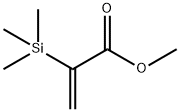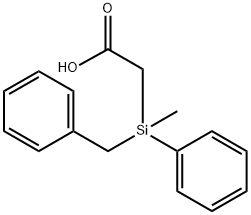(TRIMETHYLSILYL)ACETIC ACID
- CAS NO.:2345-38-2
- Empirical Formula: C5H12O2Si
- Molecular Weight: 132.23
- MDL number: MFCD00042651
- EINECS: 219-067-4
- SAFETY DATA SHEET (SDS)
- Update Date: 2024-12-18 14:15:30

What is (TRIMETHYLSILYL)ACETIC ACID?
Physical properties
mp 40 °C.
The Uses of (TRIMETHYLSILYL)ACETIC ACID
(Trimethylsilyl)acetic acid may be used in chemical synthesis.
The Uses of (TRIMETHYLSILYL)ACETIC ACID
Trimethylsilylacetic Acid is a valuable reagent used in preparation of α,β-unsaturated carboxylic acids and α-trimethylsilylbutyrolactones,
Preparation
Obtained from the reaction of trimethylsilylmethylmagnesium chloride with carbon dioxide;3 can also be prepared by reaction of acetic acid with 2 equiv of lithium diisopropylamide, followed by chlorotrimethylsilane and hydrolysis.
Properties of (TRIMETHYLSILYL)ACETIC ACID
| Melting point: | 39-42 °C(lit.) |
| Boiling point: | 90-95°C 10mm |
| Density | 0.8830 (estimate) |
| Flash point: | 203 °F |
| storage temp. | Sealed in dry,Room Temperature |
| solubility | Sol ethereal solvents. |
| form | solid |
| pka | 5.23±0.10(Predicted) |
| Hydrolytic Sensitivity | 4: no reaction with water under neutral conditions |
| Sensitive | Moisture Sensitive |
| BRN | 1679394 |
| CAS DataBase Reference | 2345-38-2(CAS DataBase Reference) |
| NIST Chemistry Reference | Acetic acid, (trimethylsilyl)-(2345-38-2) |
| EPA Substance Registry System | Acetic acid, (trimethylsilyl)- (2345-38-2) |
Safety information for (TRIMETHYLSILYL)ACETIC ACID
| Signal word | Warning |
| Pictogram(s) |
 Exclamation Mark Irritant GHS07 |
| GHS Hazard Statements |
H315:Skin corrosion/irritation H319:Serious eye damage/eye irritation H335:Specific target organ toxicity, single exposure;Respiratory tract irritation |
| Precautionary Statement Codes |
P261:Avoid breathing dust/fume/gas/mist/vapours/spray. P264:Wash hands thoroughly after handling. P264:Wash skin thouroughly after handling. P271:Use only outdoors or in a well-ventilated area. P280:Wear protective gloves/protective clothing/eye protection/face protection. P302+P352:IF ON SKIN: wash with plenty of soap and water. P305+P351+P338:IF IN EYES: Rinse cautiously with water for several minutes. Remove contact lenses, if present and easy to do. Continuerinsing. |
Computed Descriptors for (TRIMETHYLSILYL)ACETIC ACID
New Products
4-Fluorophenylacetic acid 4-Methylphenylacetic acid N-Boc-D-alaninol N-BOC-D/L-ALANINOL Tert-butyl bis(2-chloroethyl)carbamate 3-Morpholino-1-(4-nitrophenyl)-5,6-dihydropyridin- 2(1H)-one Furan-2,5-Dicarboxylic Acid Tropic acid S-2-CHLORO PROPIONIC ACID ETHYL ISOCYANOACETATE 2-Bromo-1,3-Bis(Dimethylamino)Trimethinium Hexafluorophosphate (6-METHYL-[1,3]DITHIOLO[4,5-b]QUINOXALIN-2-ONE INDAZOLE-3-CARBOXYLIC ACID 4-IODO BENZOIC ACID (2-Hydroxyphenyl)acetonitrile 4-Bromopyrazole 5,6-Dimethoxyindanone 2-(Cyanocyclohexyl)acetic acid 4-methoxy-3,5-dinitropyridine 2-aminopropyl benzoate hydrochloride 1-(4-(aminomethyl)benzyl)urea hydrochloride diethyl 2-(2-((tertbutoxycarbonyl)amino) ethyl)malonate tert-butyl 4- (ureidomethyl)benzylcarbamate Ethyl-2-chloro((4-methoxyphenyl)hydrazono)acetateRelated products of tetrahydrofuran








You may like
-
 (Trimethylsilyl)acetic acid CAS 2345-38-2View Details
(Trimethylsilyl)acetic acid CAS 2345-38-2View Details
2345-38-2 -
 2033-24-1 98%View Details
2033-24-1 98%View Details
2033-24-1 -
 1975-50-4 98%View Details
1975-50-4 98%View Details
1975-50-4 -
 2-HYDROXY BENZYL ALCOHOL 98%View Details
2-HYDROXY BENZYL ALCOHOL 98%View Details
90-01-7 -
 2-Chloro-1,3-Bis(Dimethylamino)Trimethinium Hexafluorophosphate 221615-75-4 98%View Details
2-Chloro-1,3-Bis(Dimethylamino)Trimethinium Hexafluorophosphate 221615-75-4 98%View Details
221615-75-4 -
 61397-56-6 CIS BROMO BENZOATE 98%View Details
61397-56-6 CIS BROMO BENZOATE 98%View Details
61397-56-6 -
 14714-50-2 (2-Hydroxyphenyl)acetonitrile 98+View Details
14714-50-2 (2-Hydroxyphenyl)acetonitrile 98+View Details
14714-50-2 -
 118753-70-1 98+View Details
118753-70-1 98+View Details
118753-70-1
Statement: All products displayed on this website are only used for non medical purposes such as industrial applications or scientific research, and cannot be used for clinical diagnosis or treatment of humans or animals. They are not medicinal or edible.